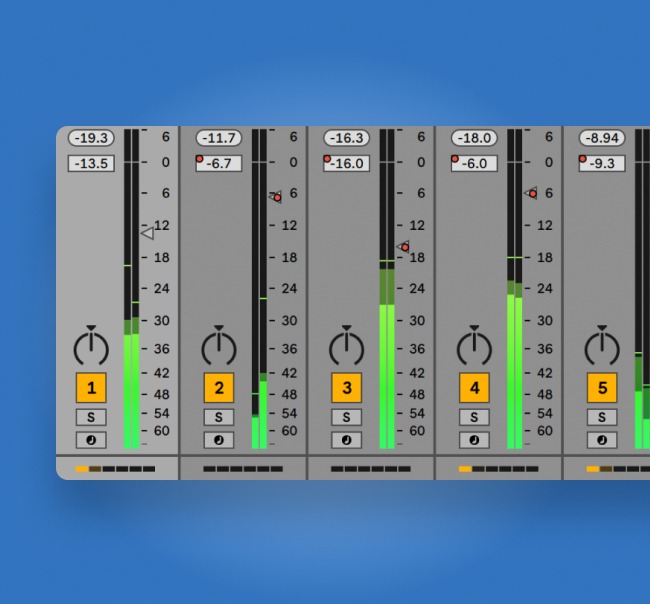Mixing Hip-Hop: The Basics You Need to Get Started

Mixing hip-hop can be much more difficult than creating it.
When inspiration strikes during your music production process, you can have a finished track in just a few hours.
But mixing it right can be a lot more difficult.
If you feel the excitement from finishing your track dying down because you have to mix it, this article is for you.
Here are my nine essential tips for mixing hip-hop that will help you finish your tracks faster.
1. Make your mix easier with good arrangement
Arrangement is how you structure the different instruments and sounds in your tracks. Getting it right can make mixing your track much easier.
Common issues like a thin or harsh mix can be fixed surprisingly well by making good choices in your arrangement.
You can use a spectrum analyzer to give you hints about what’s missing in your track and how to help fill it in. Put the analyzer on your master bus and use your eyes to see what area of the frequency spectrum might need some attention.
You might find your mix is missing an element in the low mid-range frequencies, or has too much information in the high end.
Finding samples that will complement your existing arrangement is an easy way to add some harmonic density to solve this problem. If you’re feeling stuck or you’re just pressed for time, LANDR’s Selector tool can help find complementary sounds to help fill the gap.
Common issues like a thin or harsh mix can be fixed surprisingly well by making good choices in your arrangement.
If all else fails, don’t be afraid to mute tracks or sounds that aren’t contributing positively to your mix—sometimes less is more when it comes to mixing hip-hop.
2. Gain stage your tracks for good headroom
Adding lots of tracks to your session can cause your levels to pile up at the master bus. Push it too loud and your mix will start clipping.
Clipping is the hard digital distortion that occurs when your levels go above 0 dBFS.
The problem is especially common if you’re working with normalized samples that are already close to this ceiling.
Gain staging is how you fix it. Aim for an average level of -18dB FS (or a peak level of around -10dB FS on your faders) and your signals will have a healthy level going into your master bus.
Once you’ve gain staged your tracks, start setting levels across your mix.
Think about your arrangement as you set your levels and experiment with panning What do you want to be up front? What do you want to be in the back? How wide or narrow should each element be?
Vocals tend to be the most prominent element in hip hop, along with the kick, snare, and bass. Center the rest of your mix around these prominent elements, and the rest should fall into place.
3. Use automation to get your mix moving
Automation is an underrated tool that can bring your mix to life. You can automate almost any parameter in your session.
Go through your level changes, bump up certain parts and bring down others. Try automating your panning from left to right.
Think about your musical arrangement when you’re using mix automation. Maybe you’ll want your synths to hang back in the verse and slowly get louder to stand out in the chorus.
You can also automate your plugin parameters as you add audio effects to your mix. Automated reverb or delay effects are a perfect way to make vocal hooks memorable for your listeners.
4. Keep the vocals upfront for maximum impact
Like I mentioned earlier, if your track has vocals, you want them strong and upfront in your mix. Vocals are probably the most important element when mixing hip-hop.
The real power of hip-hop vocals is in the midrange and upper mid range (2 kHz – 7 kHz). Be aware of other elements in your mix that may clash in that frequency range.
Make some subtractive EQ moves to any bright instruments to give the vocals some room to breathe.
Make some subtractive EQ moves to any bright instruments to give the vocals some room to breathe.
The voice is a very dynamic instrument, so good compression can go a long way. Use a compressor to reduce the dynamic range of the vocals so they sit right in the mix.
5. Make space for your bass to hit hard
Think about the two lowest instruments in a hip-hop track—the kick drum and the bass line.
Choosing one clear element to take up this space will make your mix more powerful.
The first frequency area to look at is the sub bass range—around 30Hz to 60Hz. You’ll need to pick one sound for this area to get the clearest, most impactful sound.
Your 808 samples are usually the best choice to dominate this range.
If you have a kick drum that plays in sync with your 808, use EQ to filter out its lowest frequencies. Let it live in the low bass range, but pay attention to the upper mids so it can punch through the mix.
Writing your 808 several octaves up to make sure it’s in tune with your song is a common trick amongst producers. After the line is written, bring the 808 back down to the sub bass range
If you’re using a kick drum, let it dominate the sub bass and have your bass line on top in the low mids.
Tuning your kick drum to the root note of your song will increase the power of the sub bass. A powerful bass drum sets up the foundation for the rest of your track.
6. Use parallel saturation to stand out
Your listeners will hear your tracks on many different systems. Devices like cell phones and laptops can’t reproduce low frequencies very well.
But you can still make your bass-heavy sounds work on these small speaker systems.
The best way to do it is to use parallel saturation on your bass instruments. Saturation creates pleasing harmonic distortion that brings out the midrange and upper harmonics in a sound.
Smaller speakers can still play back these overtones, which helps make your bass line audible. Setting up your saturation in parallel gives you the most detailed control and keeps your mix from getting harsh.
Setting up your saturation in parallel gives you the most detailed control and keeps your mix from getting harsh.
Send your bass track to an aux return channel that has a saturation plugin on it. Then mix the amount of saturated signal with the original to get the perfect balance for your track.
7. Use effects to create texture
Mixing hip-hop isn’t unlike mixing any other type of music. Audio effects like reverb, delay and modulation are essential to compliment your arrangement and add life to your track.
Mastering is the final stage in music production that gives your tracks that release-ready sound.
EQ and compression are staples when it comes to mixing, but creative effects are important too.
Reverb and delay create ambient space. This adds an atmosphere for your mix to live in and provides a sense of depth to make your strongest elements stand out.
Modulation adds motion and character to your sounds. You might be surprised by how much boring samples can come alive with the right effects. There’s no rules when it comes to creative effects!
8. Master your music for the final polish
Even if you’ve followed all the steps in this guide you might find your tracks still don’t hit quite right.
The reason why has to do with mastering. Mastering is the final stage in music production that gives your tracks that release-ready sound.
It makes the subtle tweaks needed for your music to stand up against professionally produced tracks on streaming platforms. Mastering standardizes the volume and makes your track sound more balanced across different playback systems. This is essential if you’re planning to release your music with digital distribution.
To get it right you’ll need to hire a mastering engineer or try AI-powered mastering online. LANDR mastering is the easiest way to get a solid master fast—and it costs much less than a hiring a pro mastering engineer.
Keep working on your mix
If you’ve made it through this article you’ll have a great starting point for a successful mix.
Now that you have some ideas for mixing hip-hop it’s time to get back to your DAW and finish your track.
Gear guides, tips, tutorials, inspiration and more—delivered weekly.
Keep up with the LANDR Blog.
Latest posts


